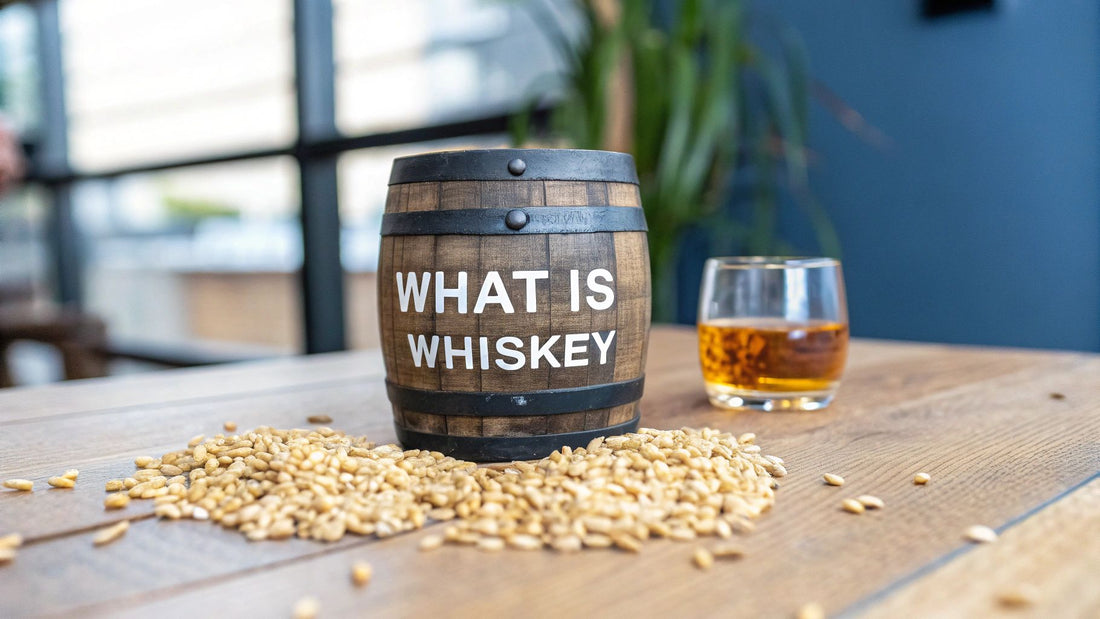So, what actually makes a whiskey, a whiskey? At its core, any whiskey is a spirit made from three non-negotiable pillars: fermented grain, distillation, and aging in a wooden barrel. That’s it. Those three steps are what transform humble grains like corn, barley, or rye into the complex spirit we all know and love.
The Three Pillars That Define Every Whiskey
Think of it like making a great loaf of sourdough bread. The specific grain recipe is your starter and flour mix, fermentation is the dough rising and developing flavor, and aging in a barrel is like the final bake in the oven. Each stage is crucial and builds upon the last, adding its own layer of character, flavor, and aroma. If one of those steps is missing, you simply don’t have whiskey.
This foundational process is what sets whiskey apart from other spirits. Vodka, for example, is typically unaged, and brandy is distilled from fruit instead of grain. It's a simple framework on the surface, but one that distillers have spent centuries mastering.
A Quick Visual Guide
To help you picture it, here's a simple breakdown of how these three pillars come together.
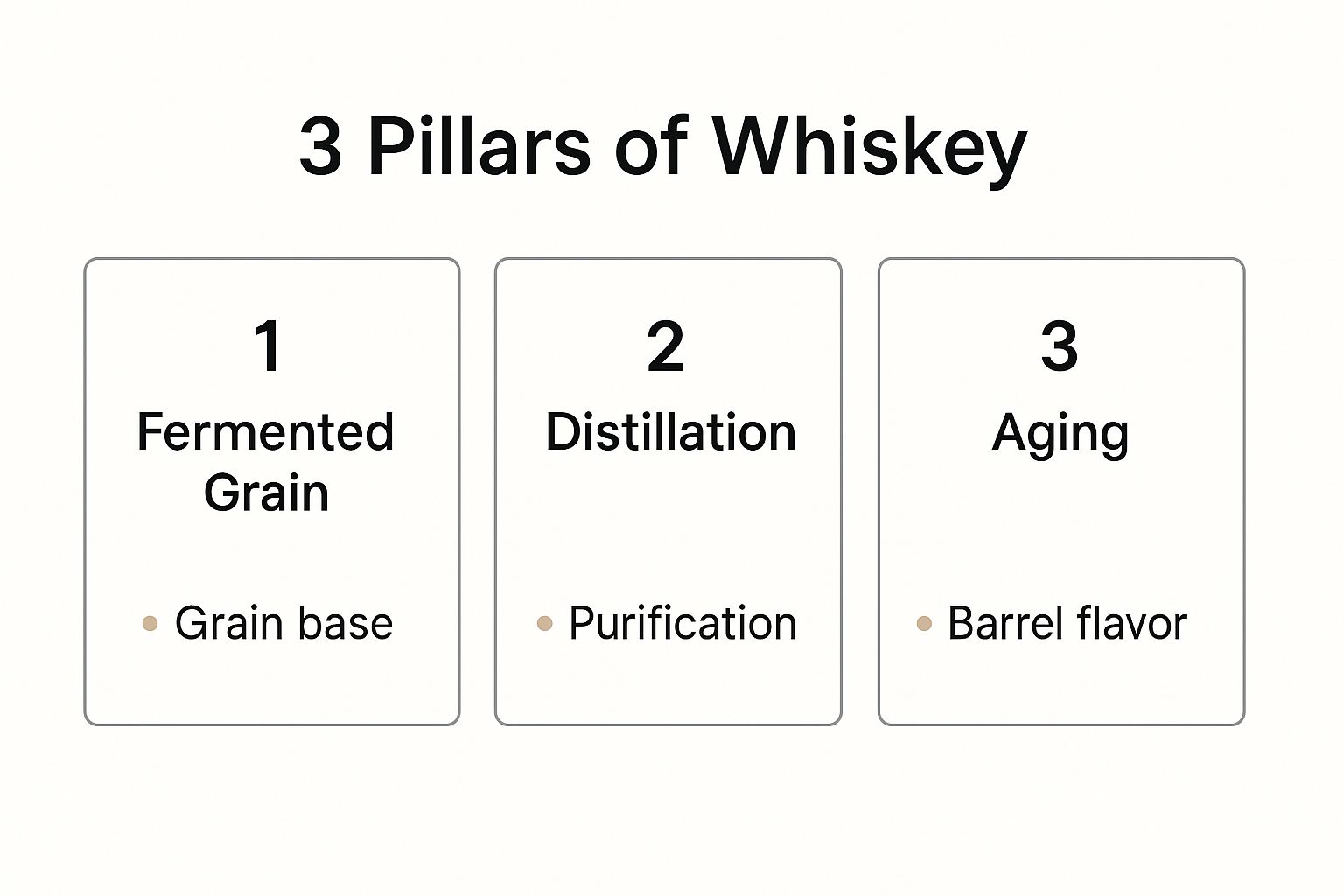
As you can see, the journey from grain to glass is a deliberate one. Each pillar has a specific job, from establishing the base flavor profile to purifying the spirit and adding layers of mature complexity over time.
This universal definition is just the starting point for a world of incredible diversity. A craft distillery like Balcones in Texas might use a unique blue corn as their base grain, giving their whiskey a distinctly Southwestern character right from the very beginning.
Tip for New Drinkers: Every whiskey, whether it’s a spicy rye from a small Indiana distillery or a smooth single malt from Scotland, begins its journey with these same three fundamental steps. Understanding them is the key to appreciating everything in your glass.
To get a better handle on the key stages, let's break them down into a simple table.
The Three Pillars of Whiskey Production
| Pillar | What It Is | Impact on Final Flavor |
|---|---|---|
| Grain Fermentation | Converting the sugars from a grain mash (like corn, rye, or barley) into alcohol using yeast. | Establishes the foundational flavor profile. Corn brings sweetness, rye adds spice, and barley offers malty, earthy notes. |
| Distillation | Heating the fermented mash to separate and concentrate the alcohol, purifying the spirit. | Determines the spirit's purity and character. The type of still and the number of distillations can create lighter or richer profiles. |
| Barrel Aging | Maturing the distilled spirit in a wooden barrel (usually oak) for a period of time. | Adds the majority of the color and flavor complexity, including notes of vanilla, caramel, oak, and spice from the wood. |
These three pillars are the universal language of whiskey, but regional traditions and distiller choices add their own unique dialects.
While the process is the same everywhere, you'll see fascinating local twists. You might even wonder about the difference between whisky and whiskey—that little "e" hints at different geographical origins and styles, which is a whole story on its own. Every single choice a distiller makes, from the grain recipe to the type of barrel, shapes the character of the final product. We'll be diving deeper into those choices as we go.
Exploring Grains and the Mash Bill
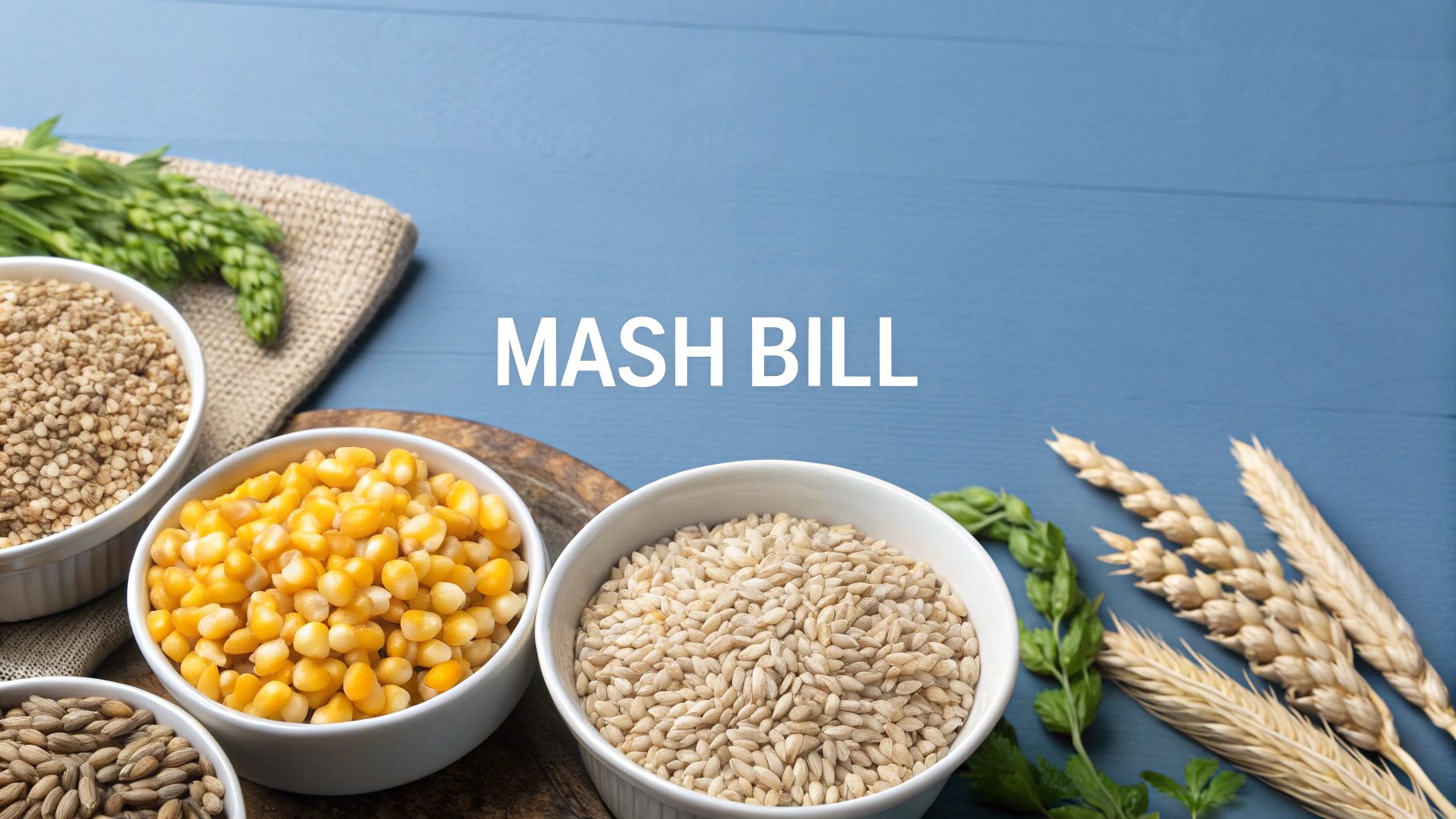
Every great whiskey, no matter how complex, starts its life as a simple pile of grain. You can think of the grain as the spirit’s DNA—it's the fundamental code that dictates a whiskey's core identity long before it ever sees the inside of a barrel. The specific grains a distiller chooses are the true starting point for the final flavor.
This grain recipe has a name: the mash bill. It’s nothing more than a list of the grains and their percentages that get cooked and fermented to create the base alcohol. Learning to decipher a mash bill is like learning a whiskey’s secret language; it gives you the power to read a label and make a pretty good guess at what you’re about to taste.
The Flavor of the Grain
In the world of American whiskey, four grains do most of the heavy lifting, and each one brings its own unique character to the party. Getting to know their signature notes is a fantastic first step for any whiskey drinker trying to figure out what they truly enjoy.
- Corn: This is the engine of American whiskey, legally required to make up at least 51% of a Bourbon's mash bill. It delivers that classic, deep sweetness with flavors of caramel, vanilla, and a distinctly creamy texture.
- Rye: Known for its bold, spicy personality, rye brings the heat. Think black pepper, baking spices, and a crispness that cuts right through the sweetness of the corn. A "high-rye" bourbon will always have a noticeable spicy kick on the finish.
- Barley: Often used in its malted form, barley provides a rich, earthy foundation for the other grains to build on. It contributes flavors of toasted bread, nuts, and a more subtle sweetness that reminds you of chocolate or nougat.
- Wheat: When a distiller swaps out rye for wheat as the secondary grain, they create a much softer, gentler profile. A "wheated" bourbon will be noticeably smoother and rounder, with delicate notes of honey and fresh bread dough instead of rye's peppery spice.
Tip for New Drinkers: A mash bill isn't just a list of ingredients; it's a statement of intent from the distiller. Not sure if you prefer sweet or spicy? Try a classic bourbon (high corn) next to a rye whiskey to see which profile you lean toward.
This is where the creativity of American craft distillers really shines. They aren’t just sticking to the classics; many are pushing the boundaries by using unique regional or heirloom grains to create spirits with a true sense of place.
Take Balcones Distilling in Texas, for example. They famously use roasted blue corn, which imparts a nutty, toasty flavor profile that is completely unique to their whiskeys. This kind of experimentation is what makes the American craft scene so exciting right now.
If you want to dive deeper into this trend, you can learn more about how distillers are exploring alternative grains in craft whiskey and creating entirely new flavor experiences. By choosing these special grains, distillers are crafting whiskeys that tell a story about where they come from.
From Beer to Spirit: The Magic of Distillation
Once the grains and yeast have done their work, what you're left with is basically a funky, low-alcohol beer. It's often called a "distiller's beer" or "wash," and it's cloudy, grainy, and not something you'd want to sip on its own.
So how do we get from that soupy brew to the clear, powerful spirit that eventually goes into a bottle? The answer is distillation—an art form as much as a science.
Think of it like reducing a sauce to concentrate its flavor. By carefully heating the wash, the distiller can separate the alcohol, which boils at a lower temperature than water. This alcohol vapor is then captured, cooled, and condensed back into a much stronger, more refined liquid. It's this critical step that officially turns a fermented grain mash into a true whiskey.
Stills: The Soul of the Spirit
The equipment a distiller uses has a massive impact on the final whiskey's character. There are really two main types of stills, and each one produces a dramatically different spirit. Knowing the difference helps you understand what to expect before you even take a sip.
- Pot Stills: These are the classic, onion-shaped copper pots you see in old-school distilleries. They work in batches and are less efficient, which is actually a good thing here. They let more of the original grain flavors and oils carry over, creating a richer, oilier, and more complex spirit.
- Column Stills: Also known as Coffey stills, these are towering industrial columns that distill continuously. Their high efficiency strips out more of the "impurities" (which also means flavor), resulting in a much lighter, cleaner, and smoother spirit.
You'll see many American craft whiskey brands, like the celebrated Westward Whiskey in Oregon, lean heavily on pot stills for their distinctive, robust American Single Malts. This choice is what gives their whiskey that rich texture and bold flavor that stands apart from the big, mass-market producers.
Tip for New Drinkers: A good distiller is like a sculptor, carefully deciding which parts of the spirit—the "cuts"—to keep. If you prefer a lighter, smoother spirit, look for Irish whiskeys, which are often triple-distilled. If you want something richer and full of grain character, seek out a pot-stilled American craft whiskey.
For someone new to whiskey, this is a difference you can genuinely feel in your mouth. A triple-distilled Irish whiskey, often made with column stills, will feel exceptionally light and smooth. But a pot-stilled American craft whiskey is going to feel much weightier, almost oily, with a deep, grain-forward character. The still truly is the soul of the spirit, defining its core texture and intensity from the very start.
The Critical Role of Aging in Oak Barrels
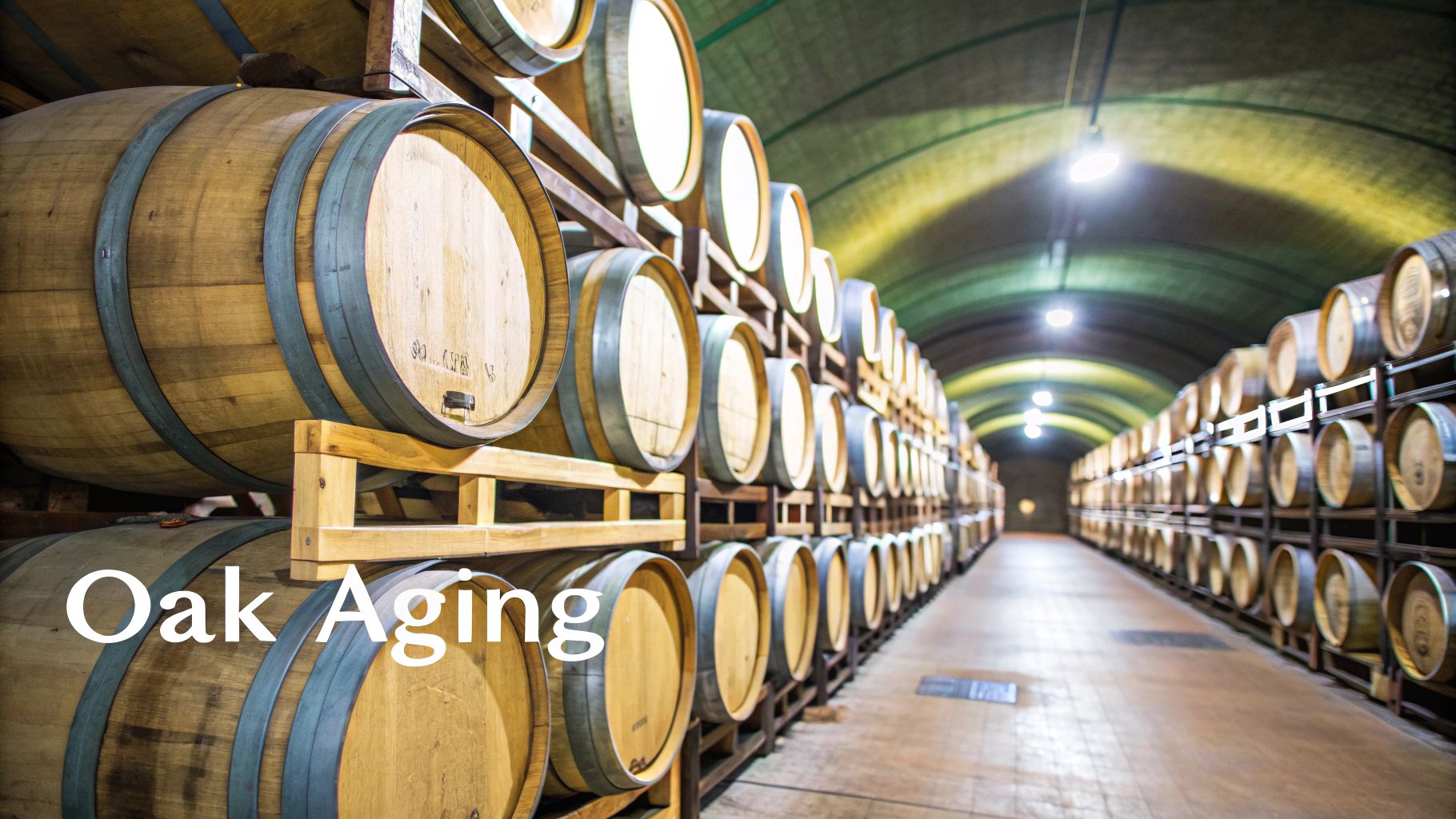
This is where the magic really happens. A raw, fiery spirit walks into a barrel, and a complex, nuanced whiskey walks out. Maturation isn't just about storing the liquid; it's an active, breathing transformation that gives a whiskey most of its color, aroma, and flavor. In fact, up to 70% of what you taste in the final pour comes directly from the wood.
Think of it like making tea. The spirit is the hot water, and the barrel is the tea bag. The longer it steeps, the more character it pulls out. The wood expands in the heat of summer, pushing the spirit deep into its pores, and contracts in the winter, pulling it all back out. This rhythmic cycle softens the harsh edges of the young spirit while layering in those classic notes of vanilla, caramel, and spice we all love. It's a true partnership between spirit and wood.
Why the Barrel Matters So Much
The specific type of oak, its history, and how it’s treated are all mission-critical to the final product. For anyone new to whiskey, just understanding the basics of barrel types is a huge shortcut to finding bottles you'll enjoy. A whiskey aged in a brand-new, heavily charred barrel will hit you with bold, sweet flavors, while one from a used barrel will be far more subtle and delicate.
This process is so essential that it’s strictly regulated by law around the world. Scotch whisky, for example, has to mature in Scotland for at least three years in oak casks. Here in the States, bourbon must be aged in new, charred oak barrels and distilled to no more than 80% ABV. These rules are what protect the integrity and distinct style of each category.
Tip for New Drinkers: The barrel is more than a container; it's the final and most important ingredient. If you enjoy bold, sweet flavors like caramel and vanilla, start with a classic bourbon, which gets all its character from a brand-new barrel.
This is also where American craft distillers really get to play. Brands like Hillrock Estate Distillery in New York are famous for their creative "finishing" techniques. They might age a bourbon in traditional barrels, then move it into a cask that once held a rich red wine, adding incredible fruity and tannic layers to the final spirit.
These extra steps are why age statements and barrel finishes are such a big deal to whiskey lovers—they tell a deeper story about the flavor inside. For a complete guide, you might be interested in our article on how aging barrels for whiskey work. It breaks down how different woods and char levels create the tastes you love, helping you connect the dots between the label and the liquid in your glass.
A Tour of Global Whiskey Styles
Ever wonder why a sweet, corn-heavy Bourbon from Kentucky tastes worlds apart from a smoky, malted barley Scotch hailing from a windswept Scottish isle? They both start with grain, get distilled, and spend time in a barrel, but that's where the similarities end. The real magic—and the flavor—comes from a combination of local laws, deep-rooted traditions, and the ingredients themselves.
Getting a handle on these differences is your key to walking into a liquor store and knowing exactly what you’re looking at.
These aren't just quirky regional habits; they're legally protected definitions that guarantee you know what’s in the bottle. This framework is crucial for an industry with combined global exports topping $14.6 billion. With consumer demand booming in markets like the UK (seeing a 15.3% CAGR) and the US (12.7% CAGR), these rules ensure that a bottle labeled "Scotch" delivers a specific, reliable experience, no matter where you are in the world. You can find out more about how these market forces shape whiskey's global trade on TradeImex.in.
The "Big Five" of the Whiskey World
The easiest way to learn the ropes is to taste the major styles side-by-side. Think of it like coffee. A dark, earthy Sumatran roast is a completely different experience from a bright, fruity Ethiopian one, even though they both come from a bean. Same idea here.
Let’s take a look at what sets the world's most popular whiskey styles apart.
Global Whiskey Styles at a Glance
For anyone new to whiskey, this table is a great starting point. It breaks down the essential rules and common flavor notes for the five most prominent styles you'll encounter. Think of it as your cheat sheet for understanding what makes each one tick.
| Whiskey Type | Country of Origin | Primary Grain | Aging Requirement | Common Flavor Profile |
|---|---|---|---|---|
| Bourbon | USA | At least 51% Corn | New, Charred Oak Barrels | Sweet, Caramel, Vanilla, Oak |
| Scotch | Scotland | Malted Barley | Used Oak Casks, 3 Years Min. | Varies: Smoky, Malty, Fruity, Floral |
| Irish Whiskey | Ireland | Barley (malted/unmalted) | Used Casks, 3 Years Min. | Smooth, Light, Fruity, Grainy |
| Rye Whiskey | USA | At least 51% Rye | New, Charred Oak Barrels | Spicy, Peppery, Herbal, Crisp |
| Japanese Whisky | Japan | Malted Barley, Corn | Various Oak Casks | Balanced, Floral, Honey, Subtle Smoke |
As you can see, simple differences in grain and barrel requirements lead to drastically different spirits. Now, let's talk about how you can experience this for yourself.
Tips for Tasting the Globe
The absolute best way to really get what makes each whiskey unique is to taste them. And you don’t need to buy five full bottles to get started.
Tip for New Drinkers: Your local whiskey bar is your best friend. Order a flight that includes a Bourbon, a Scotch, and an Irish whiskey to directly compare how mash bill and aging rules translate into flavor.
Seriously, this one simple exercise will teach you more than hours of reading ever could. You'll instantly connect the signature sweetness of corn in the Bourbon with its legal definition, and you'll notice how different it is from the smooth, approachable grain notes in the Irish whiskey.
Feeling a bit more adventurous? Find an American craft distillery that's putting a local spin on a traditional style, like a small-batch rye whiskey. It's a fantastic way to see how today's distillers can honor tradition while still creating something completely their own.
How to Start Your Whiskey Tasting Journey
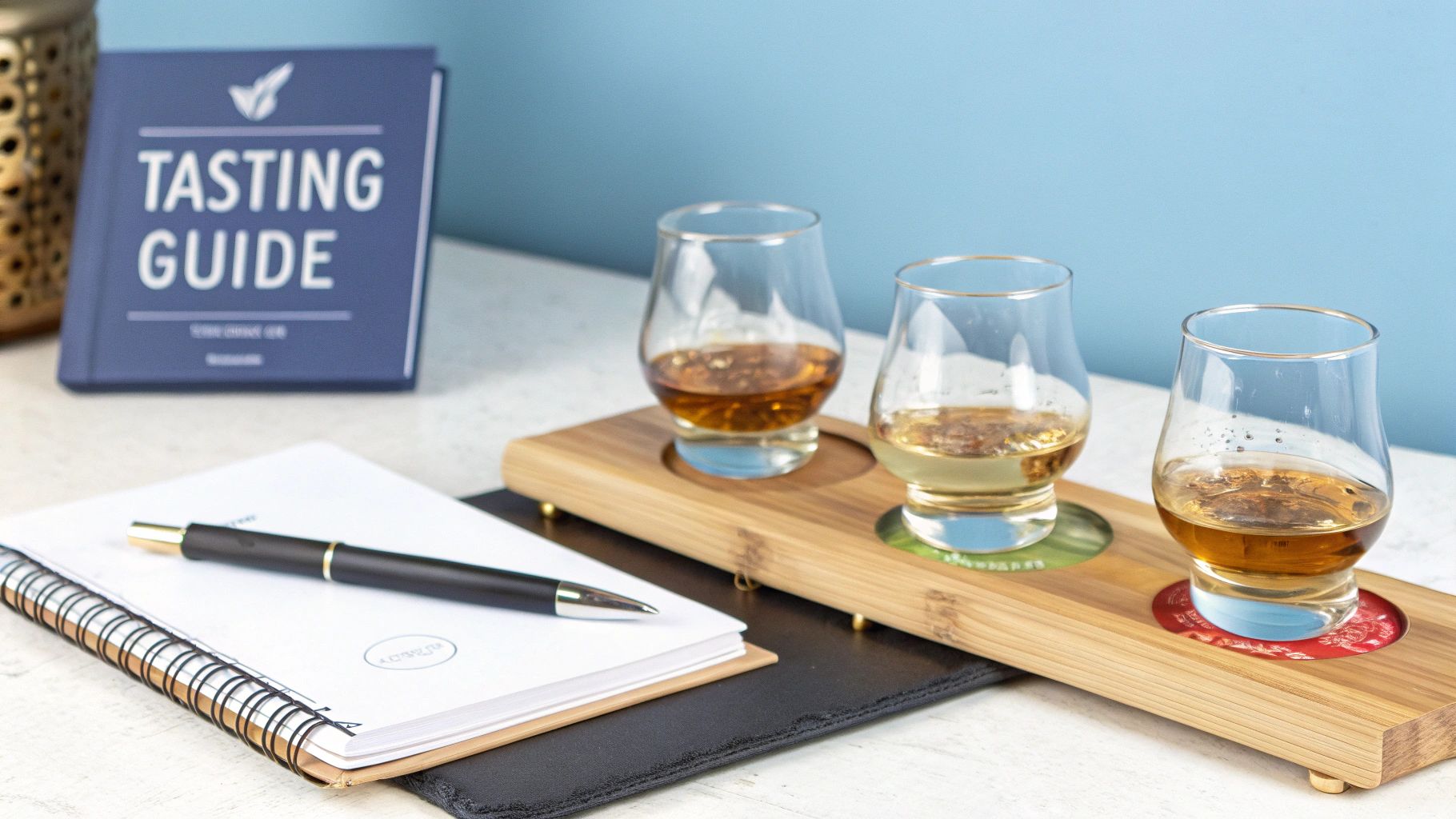
Alright, you’ve got the backstory on what makes a whiskey, well, whiskey. Now for the fun part: connecting all that knowledge to what’s actually in your glass. Tasting isn't about memorizing a dictionary of esoteric terms; it’s about figuring out what you genuinely enjoy. This is where your own adventure begins.
The global whisky market is booming, currently valued at around $106 billion, and a lot of that fire is being fueled by curious drinkers just like you. People are hungry for authentic, well-made spirits. Younger enthusiasts, in particular, are driving demand for unique expressions, proving there's never been a better time to dive in. You can get a deeper look at these market-shaping trends over at WhiskyGenius.com.
A Simple Approach to Tasting
When it comes down to it, tasting is a simple three-step dance that lets you appreciate the spirit's full character. Don't overthink it. Just tune into your senses and see what they tell you.
- Look: First, hold your glass up to the light. The color alone tells a story, hinting at the barrel type and how long the whiskey has aged. You’ll see everything from pale straw to deep, rich mahogany.
- Smell: Give the glass a gentle swirl and bring it to your nose, keeping your mouth slightly open. This is called "nosing," and honestly, it’s where you'll pick up most of the whiskey's personality—aromas like vanilla, dark fruit, or a hint of spice.
- Taste: Finally, take a small sip. Let it roll across your tongue before you swallow. Pay attention to those initial flavors, the texture or "mouthfeel," and what notes linger long after the sip is gone—that's the "finish."
This straightforward method is your key to moving beyond just "tasting whiskey" and starting to pinpoint the specific notes that you really connect with.
Tip for New Drinkers: Your first impression is rarely the whole story. A whiskey’s aroma can be completely different from its taste, and the finish might reveal entirely new flavors. Take your time with each step.
Your First Steps Into a Wider World
The absolute best way to learn is by comparing. Instead of committing to a full bottle right away, ease into it with one of these simple starting points.
- Order a Whiskey Flight: Any decent bar will offer tasting flights. Ask for one that lines up a Bourbon, a Rye, and an Irish whiskey. Tasting them side-by-side is the quickest way to truly understand how a different mash bill completely changes the game.
- Try an American Craft Whiskey: Go find a local or regional distillery. American craft distillers like Frey Ranch Distillery in Nevada have become celebrated for their "farm-to-glass" approach. It's a chance to taste something made with serious passion and a unique sense of place.
These simple experiences will help you bridge the gap between knowing about grains and barrels and actually tasting their influence in the glass. Before you know it, you'll be confidently navigating the vast and rewarding world of whiskey.
Clearing Up Common Whiskey Questions
As you get deeper into the world of whiskey, a few questions always seem to pop up. It's only natural. This last section is all about tackling those common points of confusion with clear, straightforward answers to help you feel more confident on your journey.
Think of it as a quick reference guide. We want to demystify the small details so you can get back to the big picture: finding what you love to drink. Let's clear up a few of those nagging questions that often trip up new enthusiasts.
Whiskey vs. Whisky: What's the Deal?
This is usually one of the first things every newcomer wonders about, and thankfully, the answer is way simpler than you might think. It really just boils down to geography and a bit of tradition.
- Whiskey (with an "e"): This spelling is the standard in the United States and Ireland. If you're sipping on a classic Bourbon or a smooth Irish spirit, you'll see that "e."
- Whisky (no "e"): This is how they spell it in Scotland, Canada, and Japan.
The spelling is just a nod to the spirit's regional heritage. Neither one is technically right or wrong; they just give you a clue about where that bottle came from.
What Does "Single Malt" Actually Mean?
The term "single malt" often sounds fancy and exclusive, but its definition is surprisingly direct. It simply means the whisky is made from 100% malted barley and comes from a single distillery.
That's it. It does not mean the whiskey is from a single barrel. In reality, most single malts are a blend of many different barrels from that one distillery. A master blender carefully combines them to hit a consistent and signature flavor profile, year after year.
Tip for New Drinkers: Is it okay to add water or ice to my whiskey? Absolutely. A few drops of water can "open up" a whiskey, softening the alcohol's edge and revealing more complex aromas and flavors you might have missed. Ice chills the spirit and dilutes it more slowly. There’s no wrong way to drink it—the best way is always the way you enjoy it most.
A fantastic example of this principle in action is the growing American Single Malt category. Craft distilleries like Westward Whiskey in Oregon are creating some truly incredible spirits that follow these rules to the letter. They use locally malted barley and their own unique process to produce a whiskey that is proudly from one single place, showcasing a distinct character you can only get from the Pacific Northwest. That’s what it’s all about: a unique expression of its ingredients and home.
Ready to put all this newfound knowledge to the test and figure out your personal whiskey preferences? The best way is through blind tasting. At Blind Barrels, we send you quarterly tasting kits with four unique samples from America's best craft distilleries. This lets your palate—not a fancy label—decide what you truly love. Start your tasting adventure at https://www.blindbarrels.com.
